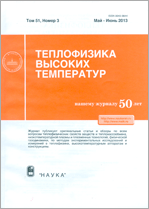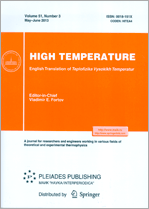|
|
Teplofizika vysokikh temperatur, 2004, Volume 42, Issue 4, Pages 516–522
(Mi tvt1552)
|
 |
|
 |
This article is cited in 18 scientific papers (total in 18 papers)
Plasma Investigations
Transverse electric discharges in supersonic air flows: Mechanisms of discharge propagation and instability
A. P. Ershov, O. S. Surkont, I. B. Timofeev, V. M. Shibkov, V. A. Chernikov
M. V. Lomonosov Moscow State University, Faculty of Physics
Abstract:
High-speed photographic recording is used to study the propagation dynamics of a pulsed transverse discharge in supersonic jets. It is demonstrated that, rather than destroying the discharge channel, the flow causes it to drift and defines the rate of propagation and, accordingly, the configuration of the discharge channel. Because a transverse discharge always has a channel part perpendicular to flow, such a discharge cannot be steady in principle. The extent of the discharge along the flow is limited by repeated breakdowns associated with one of two mechanisms of instability. The first mechanism is caused by the instability due to external electric circuit; in so doing, the repeated breakdown is the effect rather than the cause of the oscillatory pattern of burning of the discharge. In the current generator mode, when the characteristics of the external circuit do not affect the discharge, the repeated breakdown proper is the mechanism of instability of the discharge. This breakdown occurs, as a rule, between the anode and cathode parts of the discharge channel.
Received: 26.06.2003
Citation:
A. P. Ershov, O. S. Surkont, I. B. Timofeev, V. M. Shibkov, V. A. Chernikov, “Transverse electric discharges in supersonic air flows: Mechanisms of discharge propagation and instability”, TVT, 42:4 (2004), 516–522; High Temperature, 42:4 (2004), 516–522
Linking options:
https://www.mathnet.ru/eng/tvt1552 https://www.mathnet.ru/eng/tvt/v42/i4/p516
|


| Statistics & downloads: |
| Abstract page: | 190 | | Full-text PDF : | 118 |
|





 Contact us:
Contact us: Terms of Use
Terms of Use
 Registration to the website
Registration to the website Logotypes
Logotypes








 Citation in format
Citation in format 
